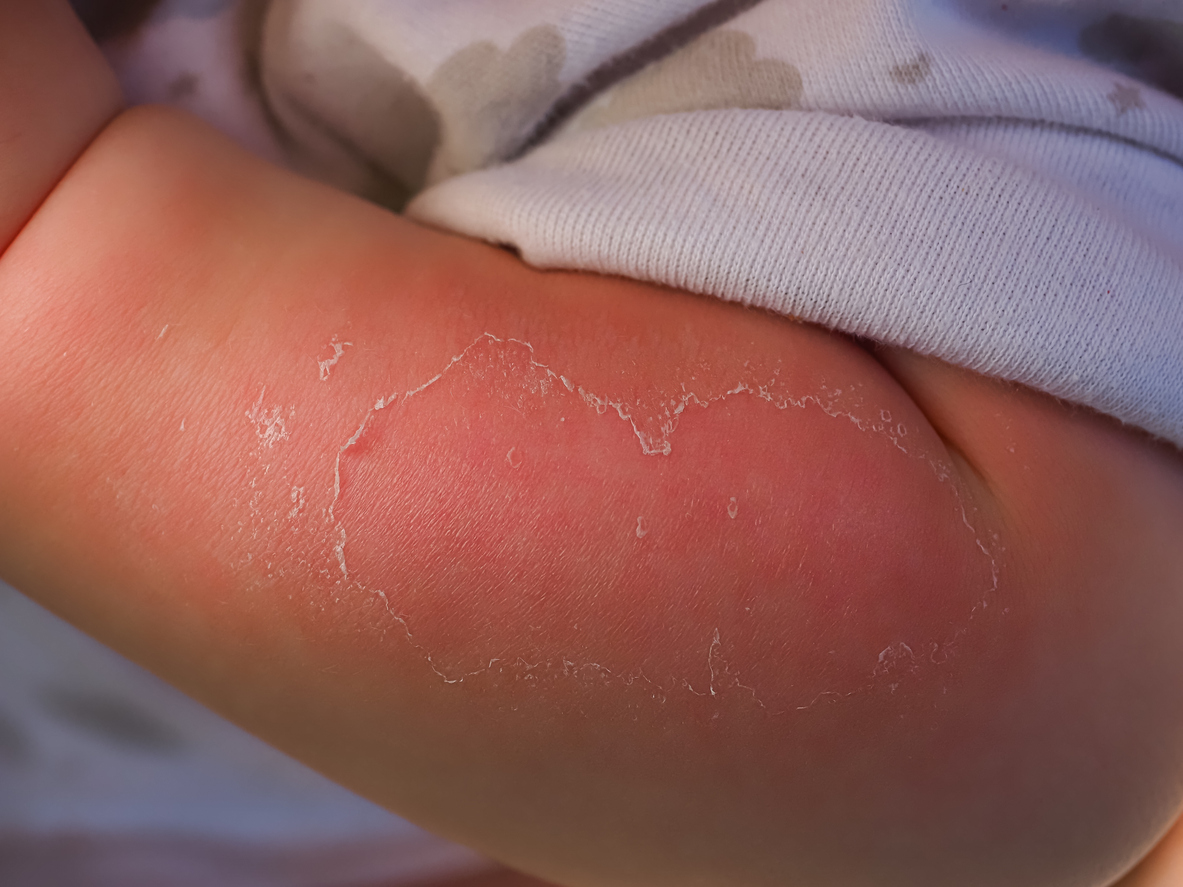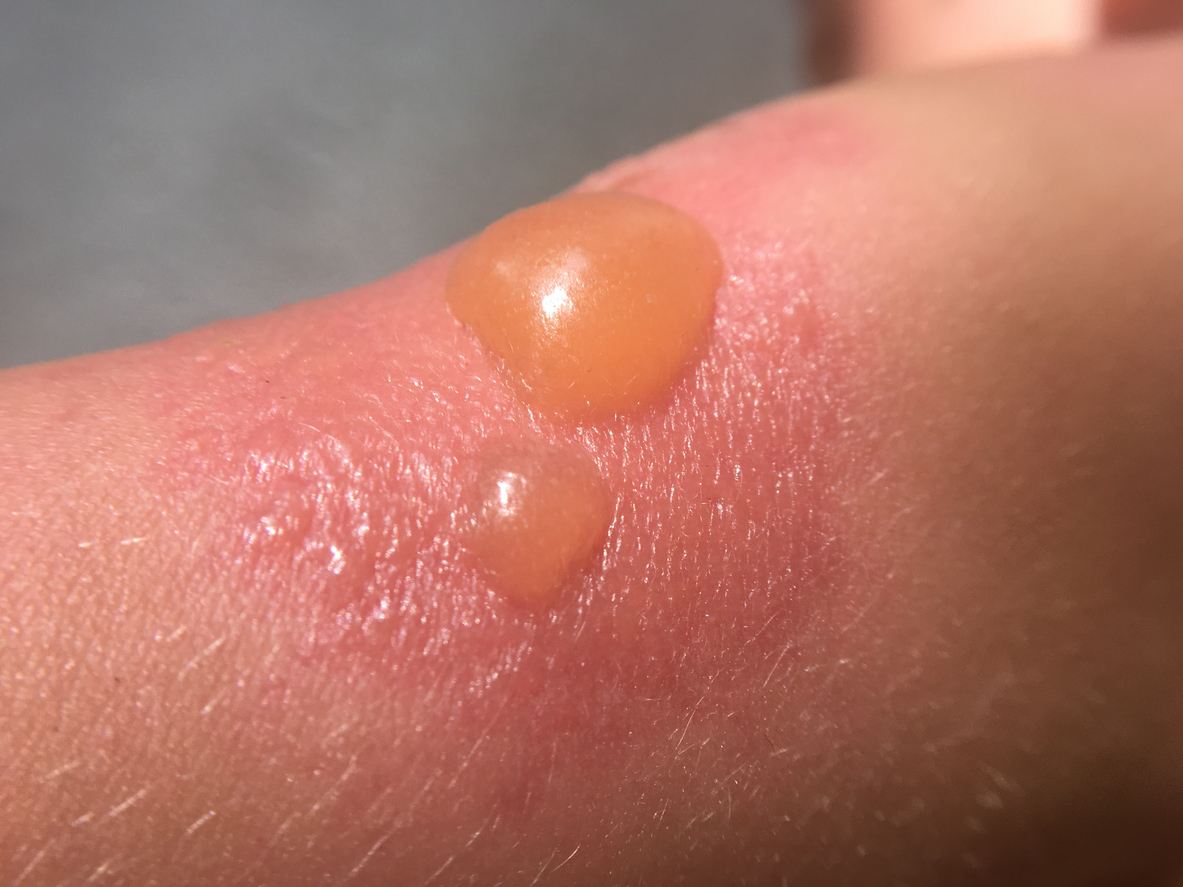As warm weather comes and the days get longer, your little ones may play outside more often. While outdoor activities are great for children's health and development, protecting them from the sun's harmful rays is important.
Sunburn is a common issue among children, with about 1 in 3 kids experiencing at least one sunburn before age 18. Many parents may not be aware of the potential dangers of sunburn and how to protect their children properly. Dr. Kristina Javier and Dr. Christina Dewey of Blueberry Pediatrics share everything parents need to know about sunburn—including how to spot it, treat it, and prevent it so you and your family can enjoy sunny days without the burn.
Key Takeaways
- Sunburn occurs when the skin is exposed to too much ultraviolet (UV) radiation from the sun. This damage to skin cells and DNA leads to inflammation, pain, and redness.
- Kids are more vulnerable to sunburn than adults because their skin is thinner and more sensitive.
- Unprotected exposure to the sun can lead to immediate discomfort and increase the risk of long-term damage, such as premature skin aging and skin cancer.
What is sunburn?
Sunburn is a sneaky inflammatory reaction in the skin, often appearing suddenly due to delayed reactions to UVA and UVB rays, which can come from natural sunlight and artificial sources.
How does sunburn occur?
Sunburn results from a combination of an individual's susceptibility to sunburn, the spectrum of the UV rays, the duration of time spent under peak sunlight hours (typically between 10 am and 4 pm), and geographic location (closer proximity to the equator increases the risk of sunburn).
On bright sunny days, one might anticipate getting sunburned and take steps to prevent it (sunscreen, protective clothing). But even on cloudy days, up to 70% of UV rays can penetrate the clouds, and reflective surfaces like snow, sand, and water can intensify exposure. Additionally, indoor sources like tanning beds also pose a risk.
Children, especially adolescents and young adults, are prone to sunburn, starting as soon as four hours after sun exposure.
What does sunburned skin look like?

Sunburned skin is characterized by redness, pain, and sometimes swelling. In more severe cases, blisters may form, and the affected area may feel warm. The skin will likely be tender and sensitive to touch.
Aside from physical discomfort, sunburns can have long-lasting effects, including premature skin aging, pronounced wrinkles, and an increased risk of skin cancer.
What is the connection between sunburn and skin cancer?
Sunburned skin in children can increase skin cancer risk later in life. The Skin Cancer Foundation notes, "Even one blistering sunburn in childhood or adolescence more than doubles your chances of developing melanoma later in life."
How long does sunburn last?
The time it takes sunburn to heal depends on its severity. Mild sunburn is the most common type, typically heals in three to five days. More severe cases of sunburn may take up to two weeks to heal.
What are the different types of sunburn?

Sunburn can range from mild to severe, depending on the level of exposure and the individual's skin type. The severity of sunburn is typically determined by the amount of redness and discomfort experienced.
First-degree (mild sunburn)
Mild sunburn is the most common type. The skin may appear slightly pink or red, but the burn is only surface-level, and there is minimal discomfort. This level of sunburn usually goes away within a few days with proper care (and staying out of the sun!).
First-degree sunburn symptoms
In addition to light pink or red skin, mild sunburn symptoms may include:
- Skin feels hot or tight
- Pain or tenderness
- Swelling
- Peeling skin (after several days)
If sunburned, your child may also experience fatigue, fever, headache, or nausea. Lighter skinned/fair haired individuals are more susceptible to sunburn, but all skin types may experience sunburn. Be especially mindful of children with dark skin tones as it may be more difficult to spot the effects of sunburn until they peel or blister.
Second-degree (moderate sunburn)
With moderate sunburns, the skin will be noticeably red, warm to the touch, and may have swelling or blistering, indicating deeper skin damage. Moderate sunburns may take up to 2-3 weeks to heal.
Second-degree sunburn symptoms
- Extremely red skin
- Blisters
- Swelling over a larger area
- Wet-looking skin
- Pain where the burn is located
- White discoloration within the burn
Additionally, your child may experience symptoms related to heat illness (heat cramps, heat exhaustion, or heat stroke). Symptoms may include confusion, dizziness, fast breathing, fever, exhaustion, headache, muscle cramps, nausea, and shivers.
Third-degree (severe sunburn)
Severe sunburn involves the deeper skin layers and increases the risk of scarring and secondary infections. It is considered a medical emergency as it can cause intense pain, fever, dehydration, and even shock.
Third-degree sunburn symptoms
- Leathery-looking burn
- Numb skin
- White or dull skin color
- Previously mentioned heat illness symptoms
Severe sunburns are rare; however, if your child suffers a severe burn, please seek medical attention immediately.
<div fs-richtext-component="cta" class="content_cta">
<div class="content-cta__title">
<div class="y-tex-xxs text-color-white">
Blueberry - Rated best for online pediatrics!
</div>
</div>
<div class="y-text-2xl text-color-white">
👩🏽⚕️ Chat With A Pediatrician About Your Child's Symptoms
</div>
<a href="https://app.blueberrypediatrics.com/join_blueberry_18a_cart?promo=blog100"
target="_blank" class="content-cta_btn w-button">
Get Started
</a>
<link rel="prefetch" href="https://app.blueberrypediatrics.com/join_blueberry_18a_cart?promo=blog100">
Who is at high risk?
Children with fair skin and red or blonde hair are at higher risk of experiencing sunburns. The nose, cheeks, ears, and shoulders are particularly vulnerable. Additionally, certain medications, such as some antibiotics and topical creams like retinoids or AHA, can increase the risk of sunburn.
Preventing sunburn

Prevention is key to mitigating sunburn risks. Here are tips every parent should follow to protect children’s skin:
- Sun Avoidance: Children under six months should be kept out of the sun to protect their extremely sensitive skin. For children over six months, it’s recommended to limit sun exposure during peak hours (10 am-4 pm).
- Protective Clothing: Wear lightweight clothing that covers the skin, including hats with wide brims and sunglasses. Darker colors and tighter weaves offer the best protection from the sun's rays.
- Sunscreen: Use broad-spectrum sunscreens with an SPF of 30 or higher. Apply sunscreen 30 minutes before going outdoors and reapply every two to three hours, more often if swimming or sweating. Look for mineral-based sunscreens (zinc oxide, titanium dioxide) because they reflect UV rays (instead of absorbing them) and are less likely to irritate sensitive skin.
- Seek Shade: Use umbrellas or stroller canopies to keep children out of direct sunlight. Encourage children to take breaks in the shade throughout the day, especially during peak sun hours.
How to treat sunburn
If your child gets sunburned, there are several ways to soothe the discomfort and promote the healing process.
- Take a cool bath: Soaking in a tub of cool water can be refreshing and cooling, but avoid adding soap, which may cause pain and irritate the skin. After the soak, gently pat the skin dry and moisturize with creams such as Cetaphil or Cerave. Avoid anything with dyes or fragrances.
- Apply moisturizer: Apply aloe vera or calamine lotion to the affected skin; do not rub it in.
- Stay hydrated: Sunburn draws fluid away from the rest of the body, so encourage drinking plenty of water (and/or Pedialyte/Pedialyte popsicles) to prevent dehydration.
- Administer pain relief medications as appropriate: Ibuprofen can help reduce inflammation and pain. For best results, it is recommended to take it as soon as possible after the burn.
- Treat peeling skin gently: Your child's damaged skin may begin to peel in a few days. Be sure to gently wash and moisturize the affected area and not pick at it.
- Stay out of the sun: Your child should completely avoid sun exposure while their skin heals.
- Let blisters heal: If blisters form, it's important to let them heal on their own. Do not pop them, as this increases the risk of infection. If a blister bursts, clean it with mild soap and water and apply an antibiotic ointment (bacitracin or mupirocin - NOT Neosporin, as it contains neomycin and many kids react to it).
When to see a doctor
If your child is less than one year old, sunburn should be treated as an emergency. Call your pediatrician immediately.
If your child is older than one and shows signs of severe pain, fever over 101 degrees, severe blistering or dehydration, or if the sunburn covers a large area of skin, it’s best to consult a doctor.
Keep your children's skin safe with Blueberry Pediatrics
Sunburn can be more than just a temporary inconvenience; it can increase the risk of skin cancer over a person's lifetime. Therefore, educating your children about sun safety and protecting them outdoors is crucial for their long-term health. And remember, warm months aren't the only time skin is at risk - even with limited sun exposure in the winter, UV rays can cause skin to burn.
Have more questions about sun exposure, sunburn, or skin care in general? You can turn to Blueberry Pediatrics for expert advice and guidance. Our team of pediatricians is dedicated to keeping your child healthy and safe, both now and in the future.
Blueberry Pediatrics is one of the largest pediatric practices in the US. Our members get unlimited, 24/7 access to board-certified pediatricians via text, phone, or video. Get care for many childhood symptoms and illnesses right from home for one low monthly or annual fee. See a doctor immediately when you sign up.
.png)








.svg)






.svg)
.svg)